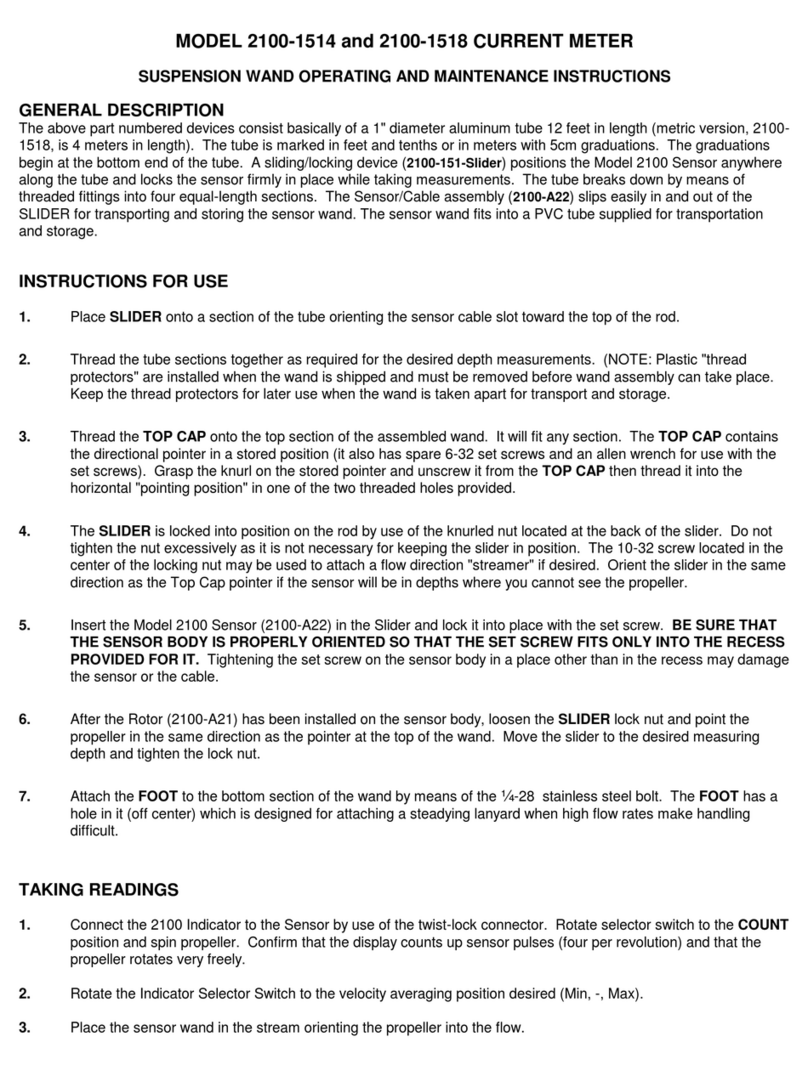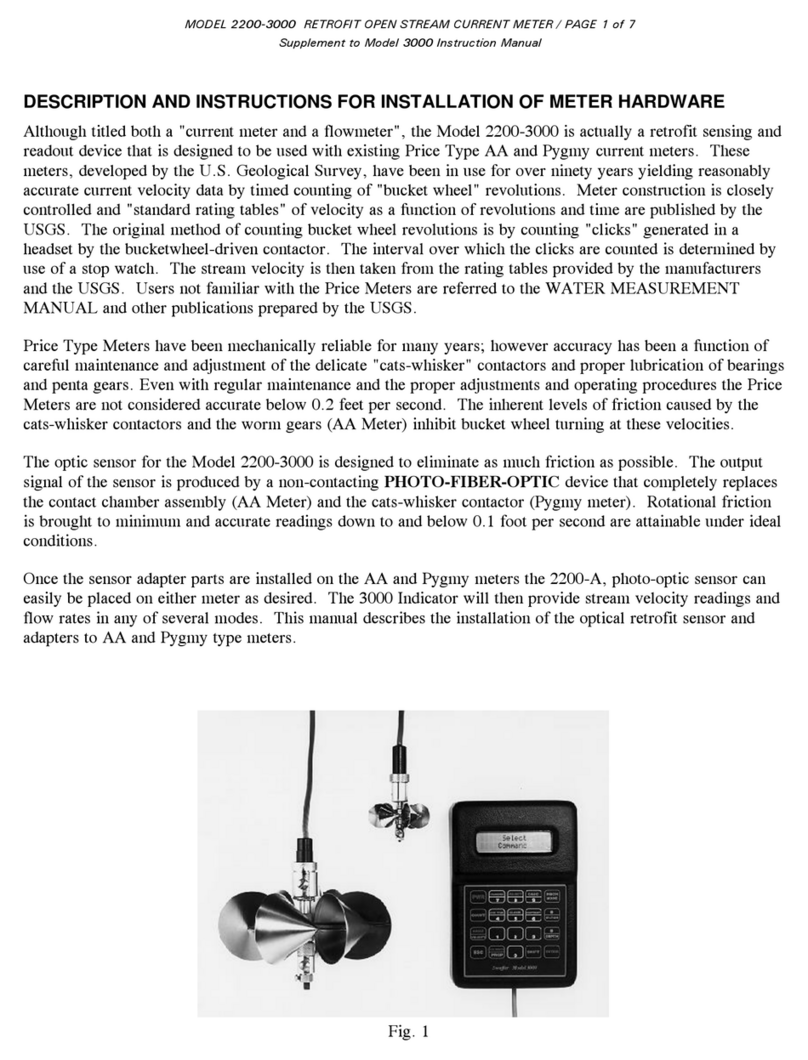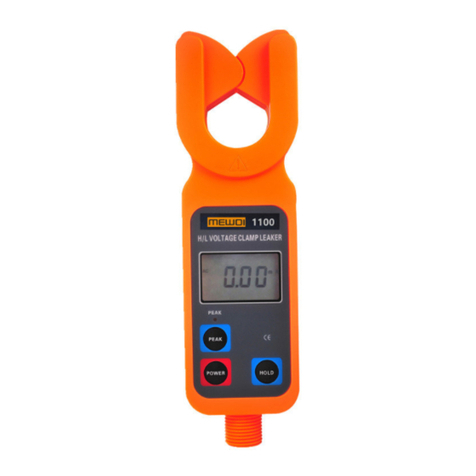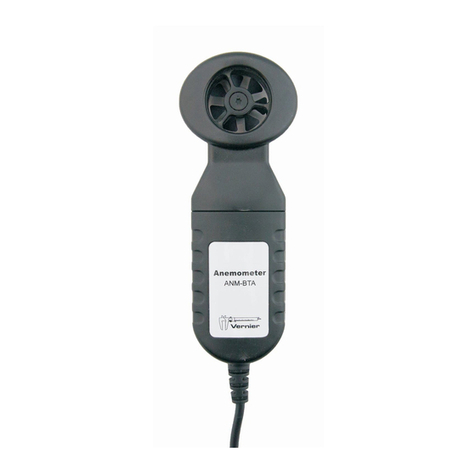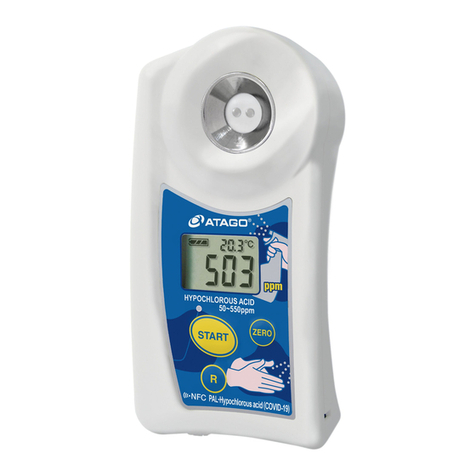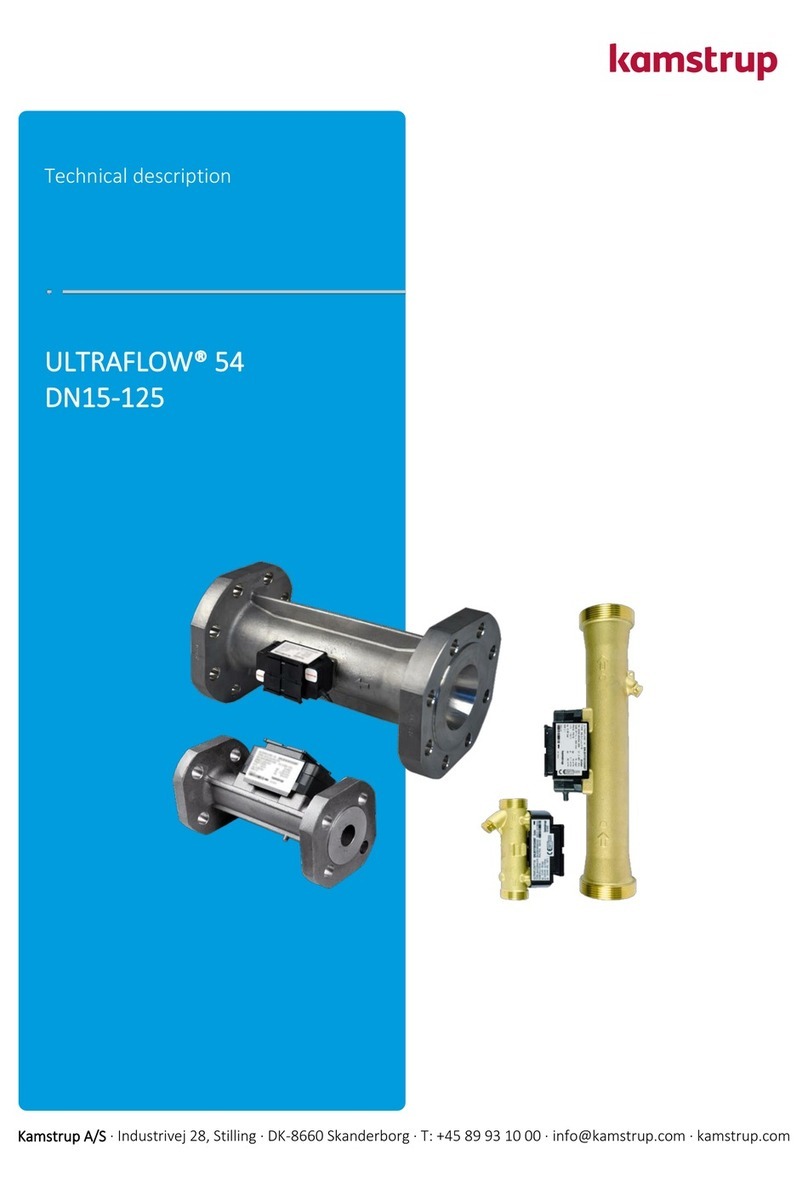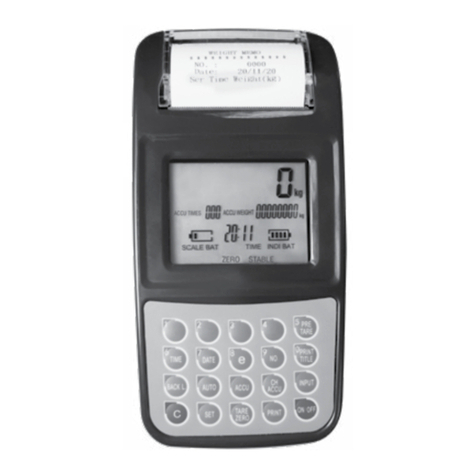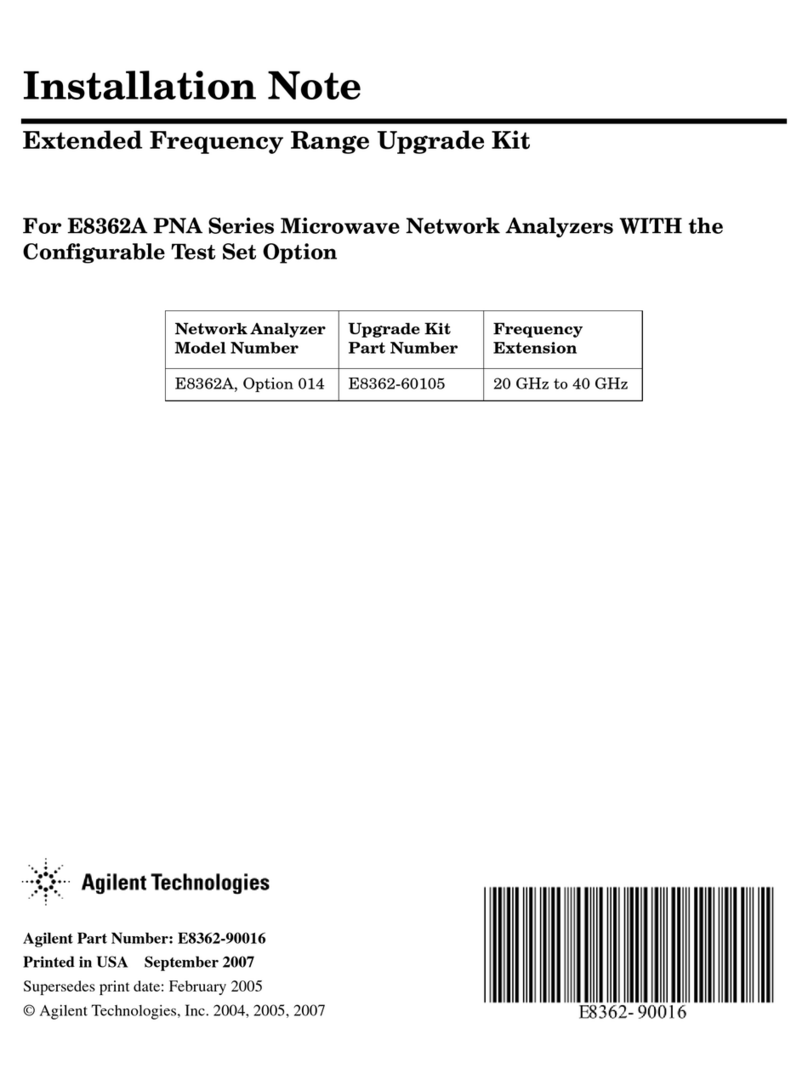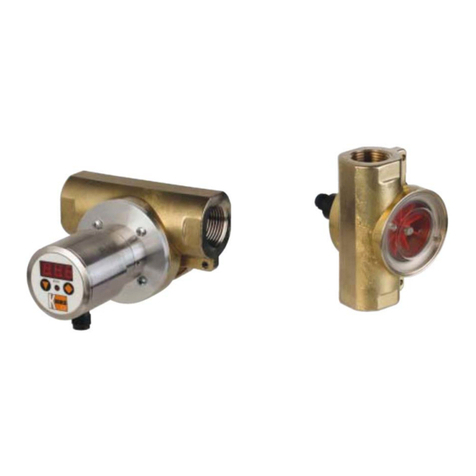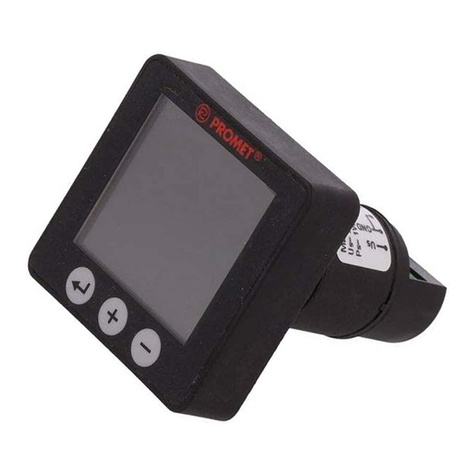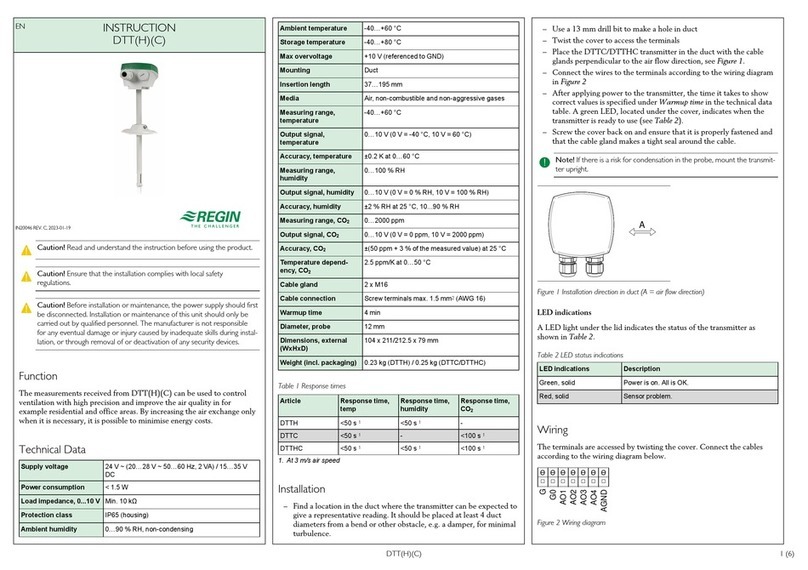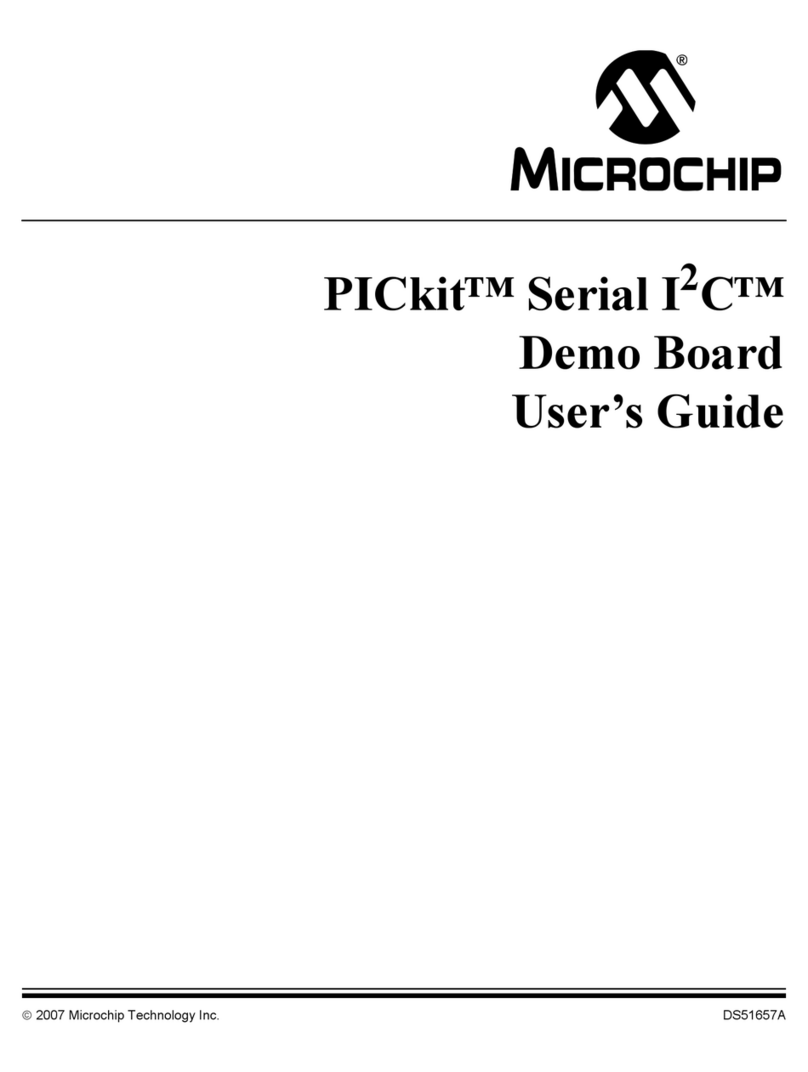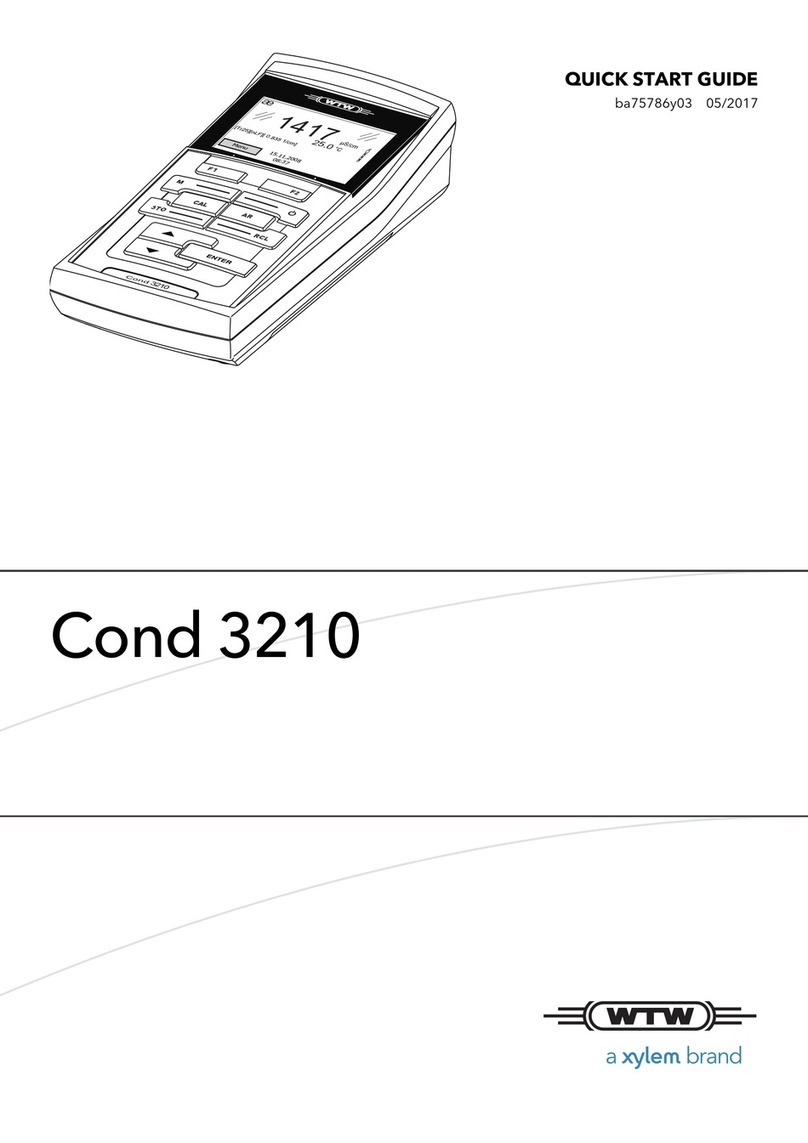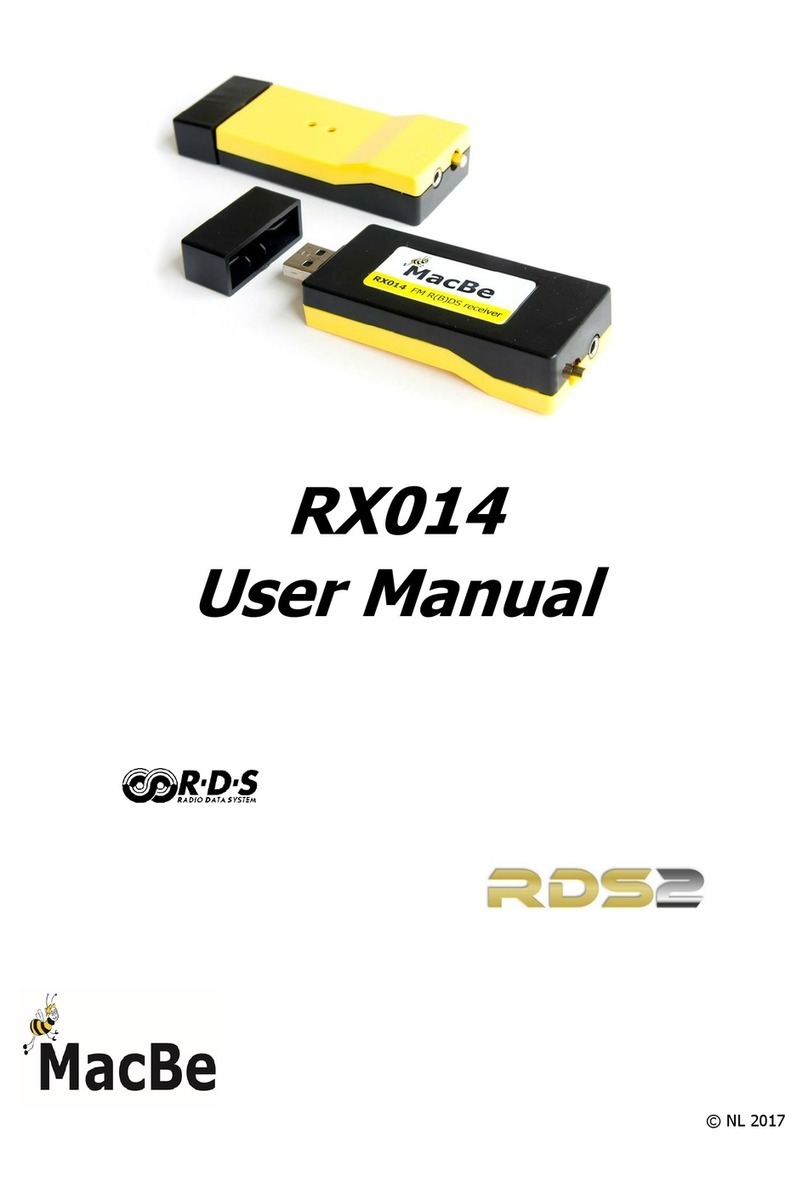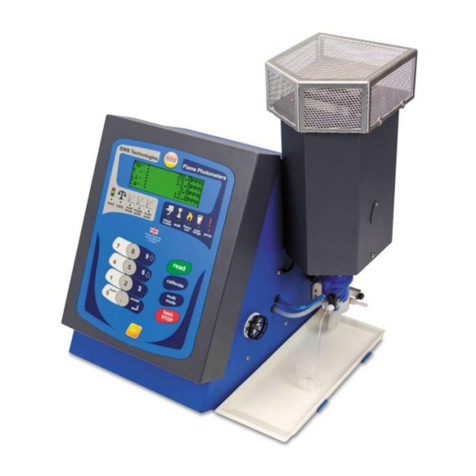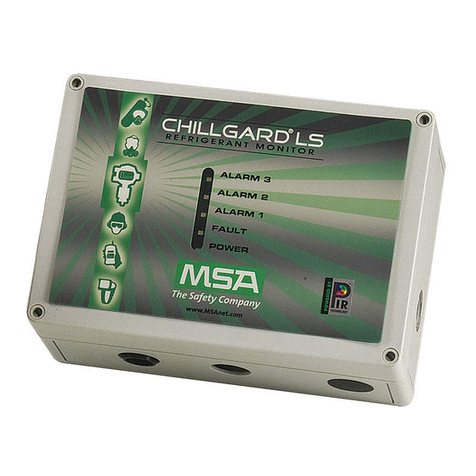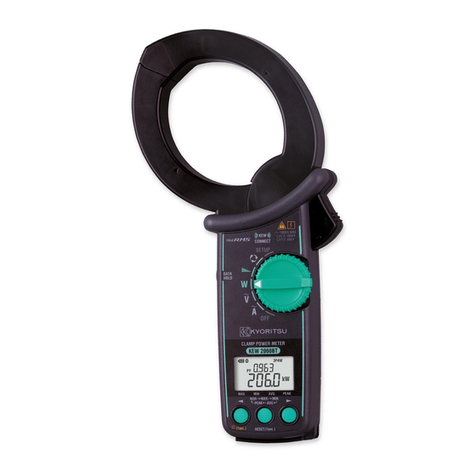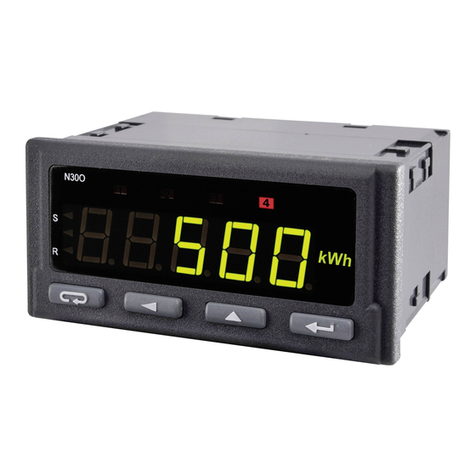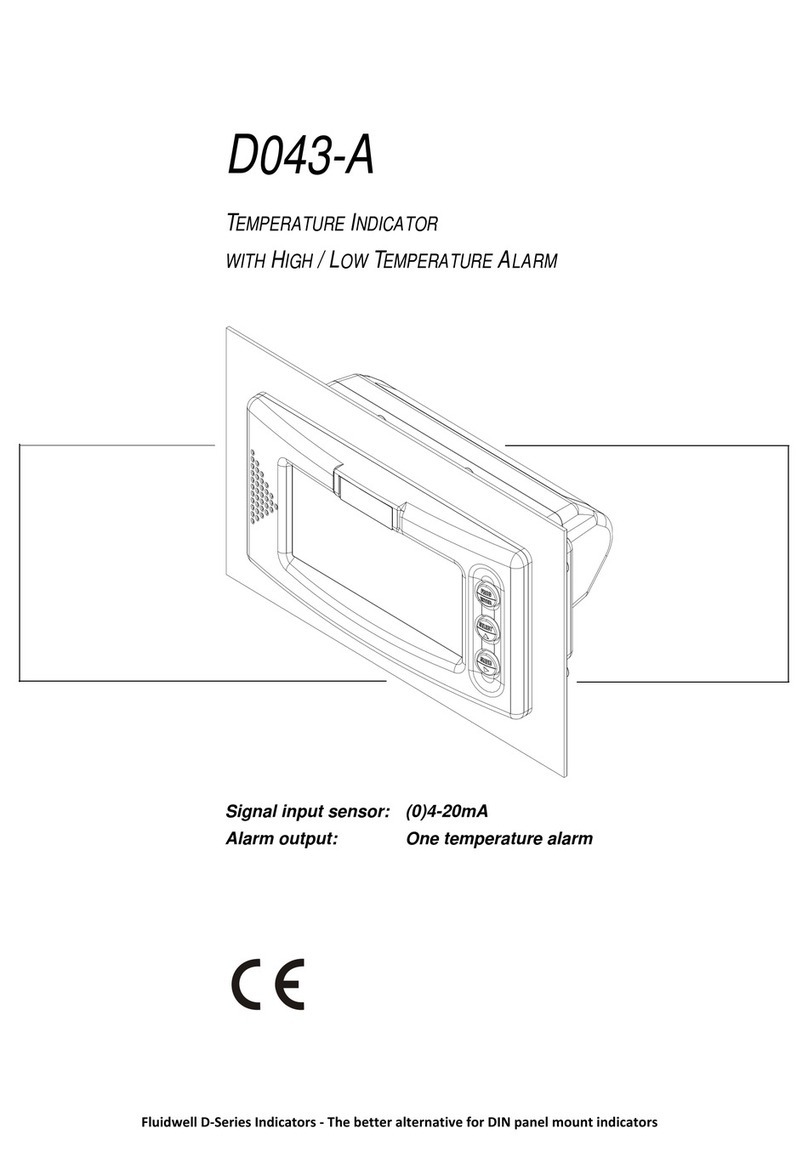Swoffer Instruments 3000 User manual

MODEL 3000
OPERATING INSTRUCTIONS
Software Version
4.1
January-03-2017
SWOFFER INSTRUMENTS, INC
1112 S. 344th St., Suite 302
Federal Way, WA 98003 USA
http://www.swoffer.com

2
TABLE OF CONTENTS
DESCRIPTION AND MODES OF OPERATION ...............................3
KEYPAD OPERATION .....................................................................4
LCD / DISPLAY OPERATION........................................................... 5
UNITS OF MEASURE.......................................................................6
MEMORY CAPACITY.......................................................................7
SELECTING A SENSOR .................................................................. 7
CALIBRATE MODE.......................................................................... 8
CALIBRATION EQUATION INPUT................................................. 11
COUNT REVOLUTIONS MODE ..................................................... 12
COUNT MODE TO DETERMINE ROTOR CONDITION ................. 13
SELECT AN AVERAGING TIME .................................................... 14
VELOCITY MODE........................................................................... 14
DISCHARGE MODE ....................................................................... 16
FLOW DIRECTION CORRECTION ................................................ 20
STATION ERASURE/STATION EDIT............................................ 21
TRANSFER DATA TO COMPUTER............................................... 21
ERASE SECTIONS................................................................... 17, 22
GLOSSARY.................................................................................... 23
SPECIFICATIONS .......................................................................... 25
DEFAULT SETTINGS AND CALIBRATION NUMBERS ................ 25
CARE & MAINTENANCE OF THE MODEL 3000 INDICATOR ...... 27
END NOTES ................................................................................... 28

3
MODEL 3000
CURRENT VELOCITY AND STREAM DISCHARGE INDICATOR
The Model 3000 is used with rotating sensor current meters for calculating, storing, and processing stream
velocity and discharge data to enable on-site evaluation. The Model 3000 can operate in units of either feet or
meters. There are four basic modes of operation:
CALIBRATE MODE
This mode is used to input directly or to field calculate the pitch of a “prop”. Field calibration is accomplished by
towing the prop through a watercourse of known length while the Model 3000 counts the number of pulses
produced. The Model 3000 then automatically calculates the prop pitch;
(1) pitch = number of pulses / course length (10 feet & 10 meters)
units are pulses per foot OR pulses per meter
COUNT (COUNT REVOLUTIONS) MODE
This mode counts prop (meter) revolutions for a user definable time period. The number of pulses per revolution
of a prop will vary for different props and rotor assemblies. After a timing period and pulses per revolution are
set the number of revolutions during the time period can be calculated; This mode is primarily used with the
USGS Price Type AA and Pygmy meters using the original "catwhisker contactor" or magnetic head (preferred),
the Swoffer optic-head retrofit (Model 2200) and the HIF version of the same, as well as OTT and other sensors.
(2) revolutions = pulses during period / pulses per revolution
VELOCITY MODE
This mode calculates the velocity of water flowing past the sensor using the formula;
(3) velocity = (n/p) / t
t = measurement period in seconds
p = prop pitch in pulses per 10 feet OR pulses per 10 meters
n = number of pulses counted during period t
dimensions are feet per second OR meters per second.
DISCHARGE MODE
This mode calculates total stream discharge using individual partial area and velocity measurements taken across
the streambed.
(4) Q = ð av
Q is total discharge in ft3per second OR m3per second
a is an individual partial cross section area
v is the corresponding mean velocity of the flow normal to the partial area
The cross section is defined by depths at locations 1, 2, 3, . . . n. At each location the velocities
are measured to obtain the mean of the vertical distribution of velocity. The partial discharge is
now computed for any partial section at location x as:

4
qx= vx[(bx-b(x-1))/2 + (b(x+1) -bx)/2]dx
= vx[b(x+1) - b(x-1)/2]dx
x = 1, 2, 3, . . . n, observation points
qx= discharge through partial section x
vx= mean velocity at location x
bx= distance from initial point to location x.
b(x-1) = distance from initial point to preceding location
b(x+1) = distance from initial point to next location
dx= depth of water at location x
The vx's in the above formula are usually measured using one of two methods:
1. Velocity measurement taken at depth (0.6)dx.
2. The average of two velocity measurements taken at depths of (0.2)dxand (0.8) dx.
NOTE: Other methods are also valid and in fact are called for in special types of measurement situations.
The ones stated here are merely shown as guides to help use the Model 3000 in natural streams.
This procedure for discharge measurement is used by the US Geological Survey and is described in detail in
Chapter A8, Discharge Measurements at Gaging Stations, a publication of the US Geological Survey. The
procedure is also covered in Hydrology and Hydraulics Systems, Ram S. Gupta, Prentice Hall, and Hydraulic
Engineering, Roberson/Cassidy/Chaudhry, Houghton Mifflin. Open-Channel Flow, M. Hanif Chaudhry, Prentice
Hall, ISBN 0-13-637141-8 is also an excellent reference work for applications in many different types of
channels.
KEYPAD OPERATION
The operator controls the Model 3000 through a 20-button keypad. The keypad is configured as 4 rows by 5
columns:

5
THE PRIMARY FUNCTIONS AND THE SHIFT FUNCTIONS
The primary functions are printed in the lower half of the key, and the shift functions are printed in the upper half.
Select a primary function by pressing only that key.
Select a shift function by first momentarily pressing the SHIFT key, then the desired key. Do not hold the SHIFT
key down while pressing a shifted function key.
POWER ON AND OFF
The PWR key turns the Model 3000 on and off. ON is instant after pressing the PWR key. OFF requires that the
key be held depressed for four seconds. The Model 3000 display counts down from three seconds to OFF while
the key is depressed.
When the Model 3000 is first powered on it will display:
M3000 (feet)
Command
The Model 3000 also has an “auto off” feature. After no keypad activity for 20 minutes, the instrument shuts
down. To restart press the PWR key. No saved data is lost at auto shutdown.
The ENTER key
The ENTER key is used to tell the Model 3000 that a number has been entered and generally to progress to the
next display screen.
The ESC (Escape) key.
One of the most important keys on the pad since it allows you to "back out" of almost anywhere and any function.
Generally, to enter into a new Function you must begin from the initial screen. Press the ESC key the number of
times necessary to reach the initial screen, which is:
M3000 (feet)
Command
For the display to show meters press the "0" (numeral zero key) at the initial screen (see UNITS OF MEASURE):
M3000 (meters)
Command
DISPLAY OPERATION
The Model 3000 communicates to the user by the Liquid Crystal Display (LCD). The display is arranged as 2
rows by 16 characters per row:

6
Model 3000 LCD
2 rows X 16 char
ENTERING NUMBERS
When the Model 3000 requires numerical input the display will show the number field to be entered with a cursor
under the rightmost digit position:
000.000
As the number keys are pressed the last number pressed will appear in the rightmost position and the other digits
will be shifted (scrolled) left. For example, if the digit "8" were pressed the display would look like this:
000.008
and after following with the digit "3":
000.083
then after pressing the digit "5":
000.835
Pressing any of the number keys will cause the digits to appear on the LCD entering from the rightmost position
while shifting the other digits to the left. The left most digit is "thrown away" each time a number key is pressed.
This means that if a mistake is made just enter zeros then the number you want until it appears correctly in the
LCD.
Press the ENTER key after you are satisfied with the number you see displayed.
IMPORTANT NOTE: Changing numbers or values is not possible without a visible cursor. Be careful however,
when you do see the cursor that you do not accidentally change figures you may only wish to view, not modify. If
the cursor is visible, you can edit the data...whether you want to or not. Pressing the ESC key when the cursor is
visible will make it disappear and prevent editing. This is most important while in the DISCHARGE MODE.
UNITS OF MEASURE
The Model 3000 can work in either feet or meters units of measure. The Model 3000 does not show the units on
the LCD except at the initial screen and in the initial screens of each cross section in the Discharge Mode. Units
may be toggled from feet to meters by simply using the 0 (zero) key while the indicator is in the initial screen
only. Each press of the 0 key will change units from feet to meters to feet, etc. The indicator will remain in the
units selected for all subsequent operations unless changed again at the initial screen. No data will be affected in
the stored registers (Discharge Mode), however, and all data once collected in feet will remain in feet and all data

7
once collected in meters will remain in meters. Data in any section in the Discharge Mode can only be viewed
and edited when the Model 3000 is toggled to the same units (feet or meters) as the original data. Once any
section has had data stored, it remains in those units unless the entire section is erased. Editing data of any cross
section in other than the original units is not possible. (see Discharge Mode instructions to follow).
MEMORY CAPACITY
The Model 3000 is capable of holding one hundred stream cross-sections (referred to as Transects or Sections)
with a total of 1000 Stations. Any combination of station numbers can be used in the Sections as long as the total
number does not exceed 1000 Stations. (Example: two Sections of 500 Stations, five Sections of 200 Stations or
one Section of 1000 Stations, etc.) Each Station stored in memory consists of, the Station Number (actual width
from initial point 0), Time & Date, Depth, Velocity, Angle and Units.
Any of the Sections may be erased completely and separately at any time without affecting any other Section and
any Station in any Section may be erased or modified at any time also.
When memory has reached the 1000 Station capacity, the Model 3000 will display "MEMORY FULL". No
further storage is possible until a Section or Sections are deliberately erased using the procedure described in the
Data Erase portion of the instructions. (p.17, 22)
SELECTING A SENSOR ( the PROP key)
Before any measurements can be made a "prop" must be selected. The default is Prop no. 1, the 2 inch propeller
that has been standard with all previous Model 2100 instruments and now standard with the Model 3000.
The Model 3000 Indicator uses calibration numbers or the "pitch" of the prop (or other type sensor connected to
it) to determine velocities. The Model 3000 indicator stores the pitches for five different props plus the USGS AA
meter, Pygmy meter and a spare location for any other "contact-closure" type sensors. The props are identified as
1, 2, 3, 4, and 5, AA 1/1, Pygmy and "Contact closure". There are two additional positions for input of the
equation supplied with AA and Pygmy Price Type vertical axis meters with their rating charts. These two
positions follow the contact closure position and are called "Equation/Contact" and "Equation/Optic". Scrolling
through the PROP menu is accomplished by pressing the PROP key repeatedly. When the last Prop position is
reached the menu returns to the first one again. (“Scrolling” of Prop selections goes only in one direction).
Selecting a Prop is done by pressing ENTER when the desired Prop is displayed. When a selection has been
made, press the ESC key to return to the initial screen. The Model 3000 will always power up with this prop
selection until changed again.
The Model 3000 comes with default calibrations for the three standard propeller - sensor combinations normally
used with the instrument. 1, 2 and 3 are the 2", 3" and 13/8" propellers. 4, 5, and “Equation/Optic” are pre-
calibrated for AA and Pygmy meters using the Swoffer Model 2200 optical retrofit sensor. Positions AA 1/1,
Pygmy, Contact closure and Equation/Contact automatically convert the Model 3000 from optical input to
contact closure input (non optical sensors) and require connecting the sensor wires to different positions in the
battery compartment. (Several options for alternate cabling hookups are available with the Model 3000 . Please
see any supplemental sheets for the most recent variations. Your version may differ in some ways.)

8
To select a prop press the PROP key, the display will look like this (with units=Feet selected):
1
Prop 1
Pitch : 186.00
If prop number 1 is not the desired prop press PROP again, the display will look like this:
Prop. 2
Pitch : 130.00
Repeated pressing of the PROP key will cause the Model 3000 to display the pitches for prop numbers 3, 4, and
5. Pressing PROP again will scroll the display to show the pitch for a USGS AA meter using the original
catwhisker contactor (one pulse per revolution) on the 1/1 connection. Pressing PROP again will display the
calibration number for a USGS Pygmy meter using the cat whisker contactor and pressing once again will display
"Contact closure", "Equation/Contact", and "Equation/Optic". The Props scroll around to No. 1 again with the
next press of the PROP key. When the desired prop number is displayed you may press the ENTER key to select
it. (See page 25 for a list of the default calibration numbers). The display will read:
Prop p
SELECTED
The Model 3000 will always use this Prop selection even after shut down and re-start until changed again.
Remember that the AA 1/1,Pygmy, Contact Closure and Equation /contact positions also change the Model 3000
from an optical input (electronic signal processing) to a contact closure type of system only.Different electrical
connections in the battery compartment are required for operation in these three positions and without changes in
the connections the Model 3000 will not operate. Be sure to check the PROP selection first before attempting to
take readings.
NOTE: Calibration numbers (Pitch) displayed for the different props represent the number of sensor pulses
produced when a sensor/propeller combination (AA and Pygmy meter included) is dragged though a distance of
ten units (feet or meters) of quiet water. The Model 3000 uses these figures along with an internal timer to
compute velocity. Default calibration numbers have been derived by Swoffer (and others) to be the norm for each
sensor/propeller combination represented, however, these can be changed to match any new or newly derived
calibrations determined by the user's field trials.
IMPORTANT ! If very accurate and consistent velocity data is to be derived from the Model 3000 then
the following calibration procedures must be put to use regularly .
CALIBRATE MODE
a: Automatic Entry of Prop Pitch by Model 3000 calculation:
<<< WARNING>>> Make sure that the Model 3000 Indicator is in the correct units mode (feet or meters)
when calibrating a sensor. I.e. do not input "metric" data while the instrument is in the "feet" mode. Your
velocity measurements as well as the discharge measurements (as calculated by the Model 3000) will be in error.
Back out using the ESC key to the initial screen and toggle the "0" key for desired units selection.

9
To determine the pitch of a propeller by actual field calibration trials use the Calibrate mode. Calibration is then
accomplished by towing the propeller through a course of known length of quiet water while the Model 3000
counts the number of sensor pulses produced. The prop pitch is then calculated:
Pitch = number of pulses pulses in 10 feet (or meters)
course length
To calibrate a propeller, first select the propeller number to be used (press PROP until the desired prop no. is
displayed then press ENTER to select it. Press ESC twice to return to the main screen. Next enter the Calibrate
mode by pressing shift then CALIBRATE. Display will read:
0 = Calculate
1 = Manual Entry
To do an actual field calibration, you will press 0. (see IN PRACTICE below)
To determine a reliable calibration number for your Model 3000 (something you must do if you are working with
slow flows [below about 1.5 FPS] and for measurements taken in very shallow streams) perform the following:
SUGGESTED METHOD OF COURSE LAYOUT AND PROCEDURE FOR FIELD CALIBRATIONS
Accurately mark a straight course of 10 to 20 feet in length in a body of calm, current-free water along which the
sensor can be towed while walking the course. A swimming pool or dock into a quiet lake serves well.
Place the sensor in the water a few feet before the beginning of the course, 6 to 12 inches below the surface. The
propeller must face into the direction of travel. Walk the sensor through the course at a rate close to that which
you will be measuring. Use the wand or wading rod rather than the sensor as a guide, press and release COUNT
at the instant the wand enters the course. The Model 3000 indicator counts the number of sensor pulses generated
as you walk through the length of the course. At the instant the wand leaves the course press and release COUNT
again. The displayed figure is the number of sensor pulses counted in the course length. Several passes through
the course in both directions will develop a reliable average calibration figure for the rotor-propeller assembly
being calibrated.
IN PRACTICE
Following the in-water placement of the sensor and the walking procedure just described:
Pressing the 0 (0=calculate) key will prompt the Model 3000 display to ask you for the course length.
Enter the length of course to be used by pressing digits followed by ENTER. Any accurately measured course
length will do since the Model 3000 adjusts the number to equal counts in 10 feet/10 meters, but the longer the
distance and the quieter the water the better.
NOTE: Be very sure which units mode the Model 3000 is in before entering figures. (Don’t enter feet as the
course distance while the Model 3000 is in the METERS mode for instance!).
Display will read:
Course length?
00.000
Press ENTER again and the display will read:
Count = _
Pass number = 1

10
Begin walking the sensor several feet before course start mark and at the instant the sensor wand enters the actual
course press the COUNT button. Display will begin counting up sensor pulses generated through the length of the
course. At the instant the wand reaches the course end, press COUNT again. Counting will stop and the Model
3000 will automatically calculate a pitch, converting the pulses into a figure in 10 feet (or 10 meters). Display
will read:
Pitch = ppp.pp
ENTER or REJECT
This pitch is entered in the memory if accepted and it is expressed as the number of sensor output pulses generated
in ten feet or meters. It is strongly advised to take four to six passes through the course in both directions to
determine a reliable average count for the pitch. The model 3000 keeps track of the number of "passes" back and
forth and you may accept or reject any pass as necessary by aborting mid-way (press ESC anytime during the
pass) or shift REJECT at the end of a pass. Press ENTER after a successful pass to save the count. Press
COUNT again to begin another pass and COUNT to stop counting at the end of the next pass. ENTER to accept.
IMPORTANT NOTE: Pressing ENTER a second time after accepting any count will total and average the counts
up to that point and will assign the average as the calibration number for that prop pitch. Once done, you have
three choices: accept the figure, enter a different figure manually, or start the passes sequence over again for a
new set of data.
b: Manual entry of Prop Pitch:
If the pitch of a propeller is known and it is desired to enter it, the manual Calibration mode is used:
<<< WARNING>>> Make sure that the Model 3000 Indicator is in the correct units mode (feet or meters)
when manually inputting calibration numbers for a sensor. I.e. do not input "metric" data while the instrument is
in the "feet" mode. Your velocity measurements as well as the discharge measurements (as calculated by the model
3000) will be in error. Back out using the ESC key to the initial screen and toggle the "0" key for units selection.
First, select the sensor (Prop No.) to be used by scrolling through the menu then pressing ENTER. ESC to the
main screen and enter the calibrate mode by pressing shift CALIB. Display will read:
0 = Calculate
1 = Manual Entry
Press 1. Display will read:
Prop # N
Pitch = PPP.PP
Enter the digits necessary to display the known calibration number (pulses per 10 units of measure). Then press
ENTER to put this calibration in the memory.
Manual Calibration mode may be used when changing optic rotor assemblies. New designs may have more (or
fewer) pulses per revolution, for instance the AA meter can have an upgraded optics rotor that has four pulses
instead of the original 2 pulses per revolution, effectively doubling the calibration number.
This method may also be used if you have calibrated propeller rotor assemblies using a different meter (Model
3000 or 2100) and you know what the calibration numbers for the propeller rotors are. A calibration number
therefore is good for a particular propeller rotor assembly regardless of what sensor and Indicator it is installed
on.
It is important to note that errors in measurements due to Calibration Number variation will be in direct
percentage proportion to the difference between the ideal (correct) Calibration Number for a Prop or rotor and

11
the number that the indicator displays for the rotor.
Example: If the ideal number is 186 and the displayed number is 184 then the velocity error due to calibration
error will be about 1%.
EQUATION / CONTACT and EQUATION / OPTIC ... CALIBRATION INPUT
In the Equation mode, the Model 3000 uses the slope - equation normally provided with some propeller and all
vertical axis meters (y=mx + b). In the Equation / Contact mode the Model 3000 converts from optic
(electronic) to contact closure input signal only (catwhisker, reed switch, etc.). In the Equation / Optic mode the
Model 3000 converts back to optical (electronic signal) input only. In both cases the operator must first tell the
Model 3000 what the variables in the equation are. <<< WARNING>>> Make sure that the Model 3000
Indicator is in the correct mode (feet or meters) when inputting the equation. I.e. do not input a "metric" equation
while the instrument is in the "feet" mode. Your velocity measurements as well as the discharge measurements (as
calculated by the Model 3000) will be in error. Back out using the ESC key to the initial screen and toggle the
"0" key for units selection.
1. Select by using the PROP key the Equation version desired. We will use the standard magnetic head input
for these instructions. Press PROP until "Equation / Contact" is displayed then press ENTER.
2. Press ESC until the initial screen is reached.
3. Press (shift) Calibrate.
4. The display will show:
m part of equation
02.1800
5. Enter the first number on the Rating Chart (for an AA meter it will probably be about 2.180, Pygmy
Meter =0.977).
6. Press ENTER again and the display will show:
b part of equation
00.0200
7. Enter the b part of the equation, usually about 0.020 for a standard AA meter (Pygmy = 0.028).
8. Press ENTER again and the screen will read;
pulses per rev
01
9. This will be the number of sensor pulses generated in one meter revolution. With an AA or Pygmy meter,
cat whisker contactor (or magnetic head), the figure should be 1. (AA meters also have a position for one
pulse in five revolutions but it is not necessary to use this position.) Optical sensors by Swoffer (2200-
3000) provide at least two and some are available with four or six pulses per revolution. Gurley Precision
makes an optical sensor that produces one pulse per revolution.
It is very important that this information be entered correctly. Count and verify the number of pulses in a
meter revolution before proceeding. If you are using fiber-optic sensors count the number of “eyes” you
see in the fiber-optics rotor. There will normally be an even number ; two, four, six, eight, etc.

12
10. When all three data are entered press ESC three times (or until the initial screen appears). You are now
ready to take velocity measurements in the normal manner using either the menu selected by the Velocity
key or the Discharge key.
COUNT REVOLUTIONS MODE
This mode is used with the US Geological Survey's Price Type AA and Pygmy current meters. The
manufacturers of these meters provide rating tables that are a listing of rotor revolutions and time periods to turn
those revolutions. Opposite these parameters are tabulated the corresponding velocities.
Before initiating this mode select the "PROP" (sensor) you will be using. The Model 3000 default for this setting
is an AA or Pygmy meter using the Swoffer optical retrofit sensor producing 2-pulses per revolution. (PROP
positions 4 [AA optic] or 5 [Pygmy optic] ). If you are using that combination no further selections are
necessary. In this mode the Model 3000 computes revolutions based on 2 pulses per rev with an opto-electronic
input signal. You may also scroll forward to “Equation/Optic” if you wish to enter the calibration equations
supplied with your AA and Pygmy meters. All these choices leave the Model 3000 Indicator in the Optic input
mode.
If you will be using an AA or Pygmy meter with the original catwhisker contactor or a Magnetic Head (preferred)
you must first do three things:
1. Scroll the PROPs key until one of the contact closure inputs is selected ("AA 1/1", "Pygmy", "Contact
Closure" or “Equation/Contact”). Without this selection the Model 3000 will process no signal .
2. Change the pulses per rev from 2 to 1 at the first COUNT screen. (If using the COUNT mode) Otherwise
revolutions shown will be ½ (or fewer) than actually turned.
3. Connect your meter to the “contact closure” posts (marked GND" and DSR) in the battery compartment.
(Note: some Model 3000 indicators have been factory modified with alternate connection methods.)
To determine the number of rotor revolutions for a selected time period the Model 3000 must receive two user
inputs: (1) Length of timing period in seconds; (2) Number of pulses per revolution of the rotor.
Press the COUNT key to enter count revolutions mode and the LCD will look like this:
Pulses / Rev. ?
00
Using the number keys enter the number of pulses produced for each prop (meter) revolution then press the
ENTER key. The LCD will then look like this:
Time period ?
00 seconds
Using the number keys enter the time period for counting revolutions, then press the ENTER key. The LCD will
then look like this:
Pulses =
ENTER to start

13
When the meter is correctly positioned and you are ready to start counting revolutions press the ENTER key and
the LCD will look like this:
Pulses = rr
Time = tt
As pulses of the rotor are counted they will be displayed on the top line. The bottom line will display seconds
remaining in the timing period.
If you wish to stop the counting, press ESC any time during the count. You may then start over.
When tt = 00 the total accumulated pulses will be divided by the pulses per revolution and the display will look
like this; showing the number of revolutions counted and the elapsed time in seconds:
rr.rr revs.
tt.tt seconds
Important Note: The final timing period displayed will always be slightly longer than that selected because timing
is stopped only after the next input pulse occurring after the timing period has counted to zero. Numbers of
revolutions may also be greater (by decimal fractions) than a whole revolution if using an optical sensor (or any
sensor) with greater than one pulse per revolution. i.e., a rotor with two pulses could produce 10.5 revs, one with
4 pulses per rev. could produce 10.25, 10.5 or 10.75 revs., etc. This will be more evident if current is very slow
and the pulses per revolution is only one; it may take several seconds for a meter to make a whole revolution after
the Model 3000 timer has counted down to zero. This method is very accurate but of course will not yield exact
corresponding figures to a standard rating table for an AA or Pygmy meter.
COUNT MODE TO DETERMINE OPTICAL ROTOR CONDITION (rotor maintenance)
You may also use the COUNT MODE of the Model 3000 to determine the condition of the bearings of a propeller
rotor assembly. The standard rotor assembly "off the shelf", equipped with the 2" propeller, should be able to
"spin up" counts from a zero reset to about 350 to 400 pulses.
Enter the Count Mode by pressing the COUNT key. You may enter the number of sensor pulses per revolution
but it is not essential for this procedure. With propeller sensors it will be four (the default in this mode is 2 so be
sure to change it). Set the Time Period to a high figure (about 100 seconds. If you do not then the meter converts
the numbers to revs at the end of the countdown and your "counts" will be ¼ that of actual pulses generated ).
Alternatively you may enter "1" as the number of pulses per rev, then after final countdown the "Revs" will equal
the "pulses" + 1 (The indicator needs to see a final pulse before producing the final result on screen).
Place the sensor in a position so that the propeller is pointing straight up in the air. Blow down as hard as you can
on the propeller and at the instant you stop blowing press and release the ENTER key. Let the rotor coast to a
stop. The final count should be at least 350 or more to equal a rotor assembly that will perform to the limits of its
design. This method requires some practice to perfect but the results are a good indicator of the response
characteristics of a particular rotor assembly. (More detailed rotor testing and care instructions are included with
the sensor wand portion of the Model 3000 instructions.) If you are not consistently getting the counts suggested
then check the method again and if valid, disassemble the rotor assembly and clean it thoroughly. You may need
to replace worn parts then give the spin test another try. Don’t be afraid to take the rotor assembly completely
apart. This should be done regularly for cleaning and maintenance anyway. Snug the thrust bearing nut so that it
will not loosen under normal use but not so tight that it may bind the fiberoptic rotor on the shaft.

14
SELECT AN AVERAGING TIME
For the Model 3000 to calculate velocity, the desired measurement period in seconds must be entered. This is
done by pressing the SHIFT key followed by the AVG. TIME key, this will cause the LCD to look like this:
Avg. period?
020 seconds
20 seconds is the default timing period. If this number does not need to be changed press ESC.
If you wish to change the timing period use the number keys to enter a new figure, then press ENTER. The
Model 3000 retains whatever value is entered. The LCD will then look like this:
Averaging period
sss seconds
Where sss can be either the original number displayed or the new value. Any number from 1 to 999 seconds is
valid and will remain as the default until changed again. Press ESC to return to the previous screen.
Note: because the Model 3000 starts and stops timing from the first input pulse (after a timing period has
started) through to the first input pulse after the timing period has stopped, the actual time in measurement
will always be slightly longer than the time selected for your averaging period.
VELOCITY MODE
Used for determining point velocities in open channels. Values cannot be stored in this mode. If storage of data
for later upload is required, use the DISCH mode.
Before using the velocity mode select a prop using the PROP key and enter a new averaging period if desired.
Default Prop is #1, 2" dia. propeller and averaging period is 20 seconds but whatever you select will become the
default.
Pressing the VELOCITY key will put the Model 3000 in velocity mode, and the LCD will look like this:
Avg. time: xx_
Avg. vel: 0.000
When the prop is in position in the stream press the ENTER key. The Model 3000 will display:
Press Enter
to start
Press Enter again and the display will instantly turn to:
Time = (your averaging time)
Pulses =

15
with the pulses counting up as the sensor rotates. The Model 3000 counts up sensor pulses as it counts down the
seconds remaining for the measurement. If the ESC key is pressed before tt = 0 then the measurement will be
aborted and the LCD will go back to the last measured velocity:
Avg. time: tt_
Avg. vel: 0.00
If allowed to proceed to the end of the timing period the display goes to:
Velocity: vv.vv
Enter or Reject
If ENTER is pressed now the velocity will be averaged with the previous one and the LCD will return to:
Avg. time tt_ sec
Enter to start
and a new measurement can be started by pressing ENTER again. If you want to average this velocity
measurement with other measurements pressing ENTER will command the Model 3000 to average a velocity with
subsequent velocity measurements.
When the measurement completes and tt = 0 then the LCD will look like this:
velocity = vv.vv
ENTER or REJECT
If you do NOT want to average this measurement, press the shift REJECT key. The LCD will then look like this:
Avg. time: tt
Avg. vel: vv.vv
Where vv.vv is the accumulated average velocity. The Model 3000 is then ready to make another velocity
measurement.
There is no limit to the number of measurements that can be taken and averaged, with the options of aborting,
rejecting, or using each measurement.
To exit the velocity mode press ESC. You may then start another series of averaged velocities by pressing
VELOCITY and beginning the process again.
NOTE: Any time you exit the velocity mode any accumulated average velocity is lost and will be reset to zero.
You may only record and store velocities in the Discharge Mode.

16
DISCHARGE MODE
Discharge mode allows the operator to make velocity and depth measurements at Stations and record this
information in the Model 3000's memory. The Model 3000 can then calculate total stream discharge using
formulas shown on pages 3 and 4 . The data stored in memory can also be transferred to a computer (page 21)
for more detailed analysis.
DEFINITIONS
SECTION A stream cross-section (Transect) made up of a series of at least two Stations.
STATION - The distance from an initial point at the edge of a stream to positions (Stations)
on a "tag line" stretched across the stream. Decimal units are in feet or meters
between 000.000 and 999.999. This number is input by the operator, and is
used by the Model 3000 to calculate total discharge.
STATION DEPTH - The measured water depth at a STATION, a decimal number between 000.000
and 999.999. This number is input by the keypad, and is used by the Model
3000 to calculate total discharge.
STATION VELOCITY - This quantity is measured using the Model 3000 at each station. Since multiple
velocity measurements can be averaged to arrive at this number the 6/10 depth
or the 2/10 - 8/10 depth method can be used. Additionally, if the flow at a
station is not at 90° to the cross-section the actual angle can be entered and the
Model 3000 will apply a cosine correction to the velocity. Used by the Model
3000 to calculate total discharge. Note: Only one velocity value is stored for
any station.
SPECIAL KEYS USED IN THE DISCHARGE MODE
There are five keys that are used only in the discharge calculation mode, they are:
DISCH MODE - Commands the Model 3000 to operate in the discharge mode. Can be addressed
only from the initial screen.
STATION - Tells the Model 3000 to ask the operator for a station number (a measured
width from an initial point at the stream edge). Indicated by a flashing cursor
under least significant digit. Possible Section numbers are 1 to 100.
DEPTH - Used to make a depth entry. Indicated by a cursor under least significant digit.
ANGLE (A shifted key) Used to modify a velocity that is not at 90° to the stream cross
section. Applies a cosine function to the velocity at the measurement point.
Normally necessary only for vertical axis meters (AA & Pygmy).
CALC - A shifted function. Tells the Model 3000 to calculate and display the total
stream discharge for a section using all station data in the memory. Select a
Section (1-100), ENTER then press shift CALC. You must have at least two
stations entered before the Model 3000 will compute a discharge.

17
When in the Discharge mode the VELOCITY key is used to tell the Model 3000 to enter the velocity calculation
mode and to save the measurement for the station.
When in the Discharge mode the shift UP arrow and shift DOWN arrow are used to scroll through the stored
Station data. (When not in the Disch mode the arrow keys are only used to adjust the display contrast).
Scrolling through the stations returns to the first station after the last one is reached. To rapidly scroll Stations
press and release the shift key then hold down a direction arrow. If you release pressure on the arrow key you
may then press shift up or down for each consecutive Station. Do not hold down the shift key while pressing
other keys…
ENTERING THE DISCHARGE MODE
To enter the Discharge mode, press the DISCH key. LCD will display:
Section: (1..100)
001
The Model 3000 shows the last Section number used and allows you to pick 1 through 100 for the next Section.
Enter the Section number desired. LCD will read:
Section : S Feet (or meters)
Stations : 0-1000
NOTE: If the section contains any stored data (Stations greater than 0) the Stations can be displayed using the shift
UP (arrow) and shift DOWN (arrow) keys. If data stored in a selected section is stored in different units from the
units selected at the initial screen (feet vs. meters) then the display reads briefly “station data has different units”
and the data in that station cannot be viewed or edited until the units are changed. Back out using the ESC key to
the initial screen, toggle the units using the 0 key then reselect the section desired.
If new data are to be obtained for this section, all previously stored station data must first be erased.
INDIVIDUAL SECTION ERASE PROCEDURE
Input the section number you wish to erase
Press shift REJECT.
Display will read:
ERASE SECTION ?
REJECT = yes
Press shift REJECT again to accomplish erasure. LCD will now read:
Section : S FEET (or meters)
Stations : 0
ALL SECTIONS ERASE PROCEDURE
Erases all Sections entirely but does not erase or reset any calibration data or other "defaults".

18
1. From the main screen press the DISCH MODE key.
2. Select section 101 and press ENTER.
Erase ALL sectns
REJECT = yes
3. Press (shift) REJECT will erase all sections. Pressing ESC first will cancel the erase procedure.
DISCHARGE MODE DATA ENTRY
To proceed with measurements in the Discharge mode press ENTER. The LCD will read:
Sta : 000.000 VEL:
D : 000.000 000.000
Press the STATION key and a cursor will appear under the least significant digit. Enter the station number (the
measured width from a zero point) and press ENTER. Cursor will disappear and LCD will read: (Where sss =
your entered number for width)
STN : SSS.SSS VEL:
D : 000.000 000.000
When station depth is determined press DEPTH key and the cursor appears under the least significant digit. Key
in the depth and press ENTER. The display will read the station number and the depth: (where ddd.ddd = your
entered value for stream depth).
STN : SSS VEL:
D : ddd.ddd 000.000
Notes: 1. Either depth or station may be entered first but Velocity mode cannot be entered until a Station number
is entered. Depth may be zero, but a Station must have a value.
2. The Model 3000 will not allow two Station numbers of the same value. If you try to enter the same number as a
Station that already exists, the Model 3000 will simply return a value of zero.
Press VELOCITY. LCD will read:
Avg. time : 20
Avg. Vel: 0.00
(where Avg. time is the Model 3000 default averaging period.)
Press ENTER and display will read:
Press ENTER
to start
When propeller is in position in the stream press ENTER to start velocity measurement. Time will begin counting
down and sensor pulses will begin counting up. (If it is desired to stop any measurement before countdown is
complete, press ESC and start over again by pressing ENTER). LCD will be reading:

19
Time = tt.t
Pulses = ppp.pp
The ending screen shows the average velocity over the timing period:
Velocity: vv.vv
Enter or Reject
Entering saves the velocity, then the display shows:
Avg. time: 20
Avg. vel: vv.vv
Pressing ENTER again allows you to take another velocity reading, averaging it with the last one(s). You may
repeat the procedure as many times as you wish to develop a multiple sample average, pressing ENTER after each
timing period ends.
Pressing shift REJECT after any timing period ends will void that period and the Model 3000 will not use it in the
average.
Pressing ESC anytime during the averaging period will stop the counts and you may start that velocity over again
from the last display screen:
Avg. time: 20
Avg. vel: vv.vv
IMPORTANT NOTE: Pressing ESC after a velocity has been completed will terminate velocity averaging for that
Station. The Model 3000 then displays all station values as have been input (depth & width) and as calculated
(velocity):
STN: www.ww VEL:
D: ddd.ddd vvv.vvv
Pressing ENTER now will save the station with the message:
Station saved
The next screen will be the SECTION number along with its number of STATIONS.
Section: 1 (2,3,4,5….)
Stations: ss
To start another Station press ENTER and a new blank Station will appear for you to repeat the above procedures:
STN: 000.000 VEL:
D: 000.000 000.000
Be sure to enter an “ending station” with a width (Station Number) but with a velocity and/or a depth of zero.
See Discharge Calculation in the next section.

20
FLOW DIRECTION CORRECTION
In some discharge measurements parts of a Station's flow direction will be at an angle other than 90° to the stream
cross-section. When this is encountered, the angle can be entered (0-90°) before the velocity measurement is
taken and the Model 3000 will then compute and display the velocity component normal to the Transect.
NOTE: Angle measurement is only available when the Model 3000 is in the velocity reading portion of the
DISCHARGE Mode. Angle cannot be used when in the VELOCITY only mode. This procedure is only needed
when using the Model 3000 with vertical axis current meters (AA and Pygmy type meters).
If no angle is entered the Model 3000 always assumes the angle is 0°.
To enter a velocity angle press VELOCITY, then press shift ANGLE. The cursor appears under the least
significant digit. Display will read:
Cosine angle =
00
Press keys to enter the angle in degrees, then press ENTER. The cursor will disappear and the angle will have
been logged as part of that Station.
Press ESC and the display will change to Velocity Mode and will read:
Avg. time: tt
Avg. vel: 00.00
The Model 3000 will now compute the velocity in the normal manner except that the displayed velocity will be the
measured value multiplied by the cosine of the entered angle. As many measurements as desired (at the same
angle) can be averaged using the same procedures listed above.
When finished averaging press ESC to display Station data.
STN: sss.sss VEL:
D: ddd.ddd vvv.vvv
Pressing ENTER ends the averaging and stores the station data with the message "Station saved".
Repeat the process for each of the desired stations across the stream.
You must re-enter any angle at each new Station.
DISCHARGE CALCULATION
At any time during a Transect the accumulated discharge can be displayed by pressing shift CALC keys. (You
must have at least two Stations in a Section for calculation of discharge). Display will read:
Section #N
DISCHARGE = QQQQ
Additional stations can be added to a Transect at any time. See following note.
Important Note: For proper discharge calculations to be made there must be a beginning and an ending Station
for any cross section. As you stretch your tag line across the stream you will almost never have the "zero point"
Table of contents
Other Swoffer Instruments Measuring Instrument manuals
